Two titans of the knowledge and collaboration tool market, Confluence and SharePoint, may spring to mind when you’re brainstorming how to share knowledge and move projects forward in your business. Knowledge management, like any area of business, requires the right tools. These tools must empower, rather than restrict, your employees.
Knowledge management tools have never ceased to evolve over the years. This means you have more options than Confluence or SharePoint to help you manage and share knowledge – especially these days. If your organization or team is interested in knowledge sharing in particular, modern knowledge base software can offer incredible benefits – alongside an extremely intuitive interface.
Enterprise software is not always the answer. Sometimes, it’s better to choose a solution with a more specialist function – one that’s much more suited to sharing knowledge internally. This is where tools like Document360 come into their own. More on this later.
Confluence vs SharePoint for Knowledge Management
Technologies and processes are designed to enable organizational insights and meet business objectives by capturing, creating, sharing, using, and accessing knowledge. Additionally, knowledge can be derived from tacit, structured, unstructured, learned, analyzed, or processed information.
Note that this definition includes technologies that facilitate knowledge management. KM software is integral to the definition of the field itself. Managing software is exactly what these tools do.
With Confluence and SharePoint, both solutions tend to facilitate internal knowledge-sharing with some varied features. For example, Confluence is tightly focused on knowledge management with additional feeds and content pages, making knowledge social. SharePoint offers something a little extra. SharePoint is also an intranet and can create microsites where teams can share resources and co-author content.
Teams love Confluence because it is part of the Atlassian suite. Atlassian builds popular tools such as Trello and Jira, which many organizations use. Other teams will swear by SharePoint because of their loyalty to other Microsoft products, such as Office 365. There are benefits and drawbacks to both approaches.
At a Glance Comparison: Confluence vs Microsoft SharePoint
|
Confluence |
SharePoint |
|
Workspaces and pages |
Intranets and microsites |
|
Collaborative real-time editing |
Document storage and search |
|
Versioning and rollback |
Versioning and numbering |
|
Integrations with Atlassian and marketplace apps |
Integrations with Microsoft 365 and related products |
|
Customize workspace styling |
Extensive customizations |
|
Many integrations |
Integrations with Office products |
|
One site limit |
Up to 2,000 hubs |
|
Deployed in the cloud |
SharePoint Online part of Office 365 |
Switch over to a simple alternative to Confluence and Sharepoint!
Confluence vs Microsoft Sharepoint Features Comparison
Now, we’re going to take a deep dive into a comparison of Confluence and SharePoint features, respectively.
Confluence
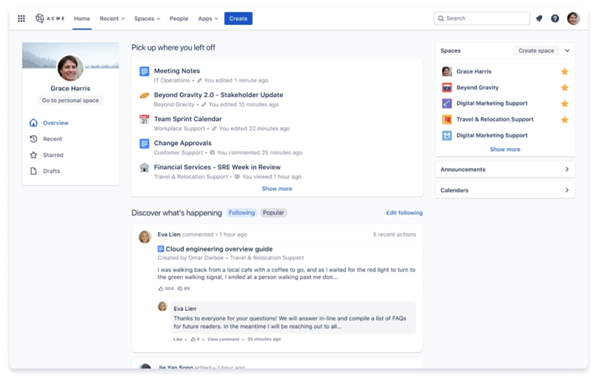
Confluence likes to emphasize knowledge-sharing and the ability to collaborate. This makes Confluence’s approach to knowledge very dynamic since it recognizes that knowledge exists within a context and must be useful to users. Confluence is intended for all types of teams, ranging from IT to support to marketing to HR. Confluence is quite simple to use out of the box and offers a lot of potential.
Key features:
Co-editing in Real-time & Inline Comments
Many users like Confluence for the ability to co-edit and create content in real time with colleagues. This is alongside inline comments and tagging, and up to twelve people can collaborate at any one time. Like the Google Docs platform, Confluence is a content collaboration tool.
Powerful Macros for Custom Functionality
Confluence macros can give you added functionality to what Confluence calls your Pages. For example, you can use the Attachments macro to list all the files attached to Page. You can use the Widget Connector macros to include a YouTube video or Twitter feed.
Extensive Integrations with Leading Tools
Confluence encourages you to integrate with Jira so you can share knowledge and track tasks at the same time. Confluence also uses add-ons from the Atlassian Marketplace to provide further integrations with leading tools. You could get Confluence updates in Slack, for example, if Slack is your primary communication tool.
Access Ready-to-use Templates
Pre-format your content with templates to quickly launch a business strategy or take meeting notes without starting from scratch. You can also create custom templates in case you find a format you want to reuse for your business.
Collaboration on a Visual Whiteboard
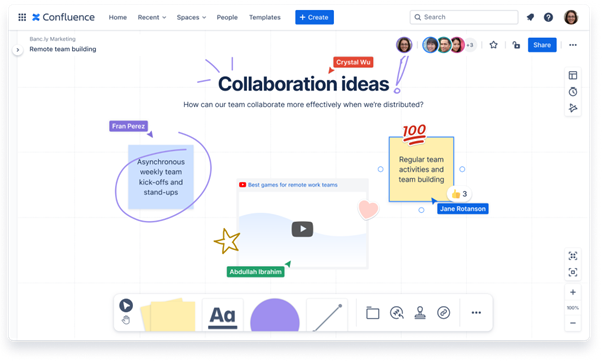
Whiteboards are an exciting feature of Confluence, which allows you to collaborate visually with team members on ideas. You can use one click to turn a sticky note into a Jira issue, embed a YouTube video in your whiteboard for even greater clarity, and change colors and fonts to suit your team’s mood or brand.
Considerations When Using Confluence
Customization Options
While Confluence offers a range of add-ons and integrations, customizing it can be more complex than SharePoint. You may need an IT administrator to invest considerable time in customization, which can make it tricky to adapt Confluence for use cases beyond its primary design.
Search Functionality
Users find Confluence functionality a bit confusing. This means that the users have spenta little more extra time in locating the document though they knew the document existed.
Custom Domain
While this feature is on the way, creating a custom domain for your documentation in Atlassian Confluence is currently unsupported. Since it’s been in beta for several years, if a custom domain is crucial for your business, Confluence may not be the best fit.
Content Reuse
Confluence primarily focuses on documentation and collaboration, with less emphasis on reusing content across projects or sharing workspaces. This means that even if you are creating internal knowledge repositories for multiple teams, you have to start from scratch every time.
User interface can be a mixed experience
Users sometimes struggle with the Confluence user interface because of issues with their browsers, extensions, and versions. Some users consider the interface unappealing and unintuitive, although this is a subjective opinion, and you may find it to your liking.
User opinion about Confluence from G2
“What I love the most about Confluence is the fact that it is so easy to use, considering that it has a vast amount of templates for different documents and projects. This makes it easier to begin any project or work on any document because a lot of people struggle with starting. I also love the fact that it makes it easier to collaborate because of being cloud-based. We can collaborate as a team in real-time, and if we are working on a project, it helps a lot to have everyone on the same page in real-time.”
Interested in Document360 AI- Powered Knowledge Base? Schedule a demo with one of our experts
Book A Demo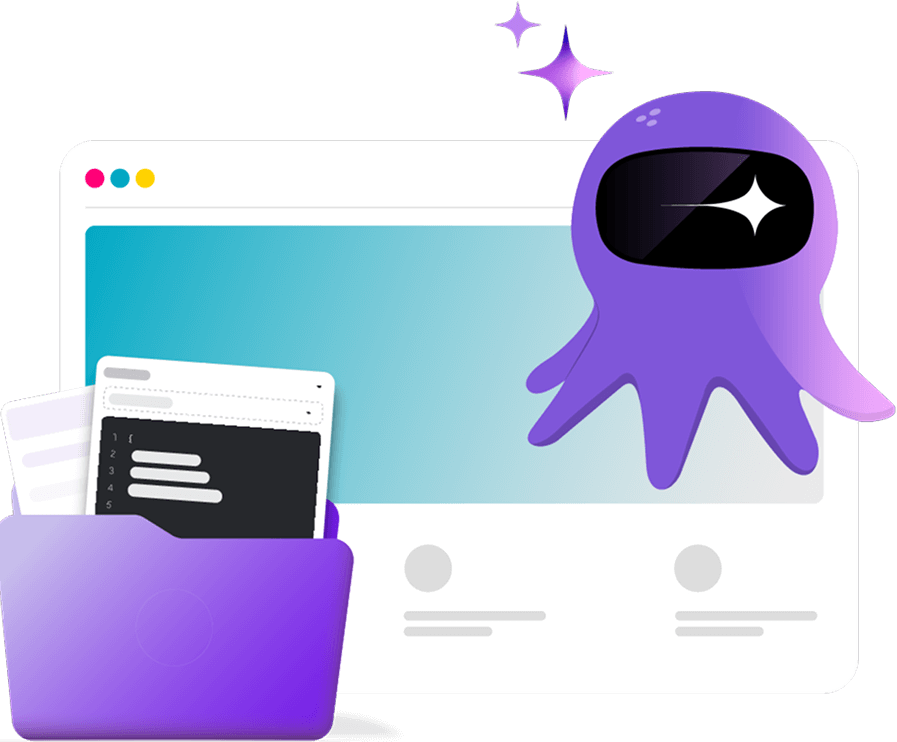
Microsoft SharePoint
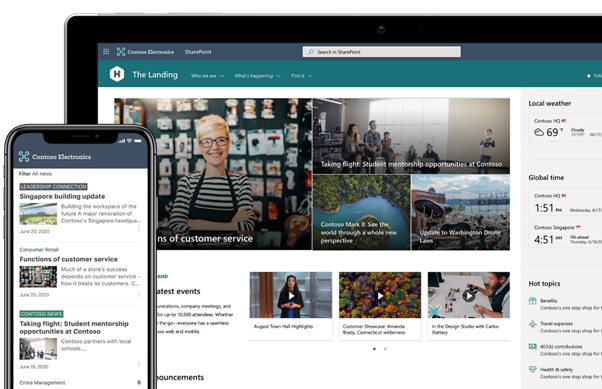
Since SharePoint has been around since 2001, Microsoft has had time to add many features and make many updates since then. The result is a tool with a plethora of features that require extensive training to use and specialist help to implement. SharePoint can do a lot, but you’ll need the right resources to make the investment worth it. Since launching SharePoint online as part of Microsoft 365, even smaller businesses can take advantage of SharePoint without having to maintain costly servers.
Key features:
Integration with Microsoft 365 Suite
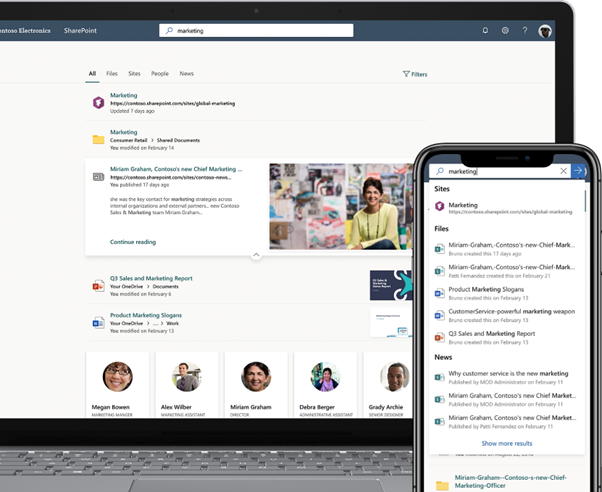
Naturally, SharePoint works well with Microsoft 365, integrating with business tools such as Word, Excel, PowerPoint, OneDrive, and Teams. This means you can keep using all your favorite SharePoint tools and stay comfortably within the Microsoft ecosystem. Compatible file types such as Word and Excel work well with SharePoint. Anything you might want to do from a business perspective is technically possible with this approach.
Easier Onboarding for Microsoft Users
Your team will find onboarding much easier if they are already Microsoft users. And let’s face it: there aren’t many office workers who haven’t used any of Microsoft’s tools. This comfort and familiarity is a key feature of SharePoint.
Effective Intranet Solution
Many companies have tried to build intranet software, but SharePoint has consistently been a winner. As a one-stop shop for common applications and resources, employees can follow workflows, communicate, and share updates every time they log onto your business network.
Automation of Repetitive Tasks
SharePoint can help you manage approval flows, work with files and lists, and route finished documents. This means you can standardize a process and complete it every time using automation. Employees are more likely to stick to your policies with SharePoint. Thus, SharePoint facilitates better teamwork, compliance, and productivity.
Highly Customizable
Many teams love the ability to customize SharePoint to suit their own needs. Although complex and feature-heavy, if you can think of a scenario, you can probably accomplish it with SharePoint.
Considerations When Using SharePoint
Requires Time to Learn
SharePoint is powerful but it takes time to learn to get the most out of it. Users like it, but they need training. This means you might train employees once when you implement SharePoint, but you’ll be obligated to train new hires again every time someone moves on. This makes SharePoint a tool for experts.. Administrators also face challenges in learning to use the interface.
Customization
In SharePoint, you can create customized intranets, communication portals, and microsites to connect your whole team. For example, customized site branding, customized workflows, and customized themes are all possible. Technical expertise is required to customize SharePoint..
Integration with Non-Microsoft tools
Sharepoint works great with Microsoft Ecosystem, but stepping outside can be tricky. If you decide to start using Microsoft, you are relatively committed to a specific set of options when it comes to integrations. This is a problem for more complex software environments.
Number of Users
Even if you have a read-only site in SharePoint, anyone accessing your content must be a registered user with a subscription seat. This can either limit the user base or increase your cost.There’s a reason that SharePoint is associated with the enterprise.
Subpar Search Functionality
As with Confluence, users also struggle to make use of the search function in SharePoint. This means your sprawling network of sites, intranets, and documents can quickly become impenetrable. Even when users are aware of a page and can access it via a direct URL, the search may still fall short, often due to inconsistent metadata handling.
Costs across the board
Involving everyone in SharePoint can be quite resource-intensive, especially if you opt for a plan that includes all the necessary features. Additionally, there are ongoing expenses for training, administration, consulting, governance, and other related costs, which can add up quickly.
AI Features Require Add-Ons
To add AI smarts, you need to integrate it with something like Microsoft Copilot, which comes with an extra price tag
User opinion about SharePoint from G2
“Microsoft SharePoint provides an excellent platform for collaboration. We use it as our Intranet, but it’s also the foundation of OneDrive and Teams. As a result, our entire company runs on SharePoint in one way or another. Every Team member uses it every day. We’ve integrated OneDrive, which runs on SharePoint, as our file storage for all of our user’s information. This makes transitioning from one device to another seamless. SharePoint is easy to set up, and once you learn its quirks, administering it is not difficult.”
Also Read: Best 9 SharePoint Alternatives to Boost Collaboration
Document360 as an alternative to Confluence & SharePoint
If you’re looking for a knowledge-sharing platform, then you should consider Document360 as an alternative to Confluence or SharePoint. Companies implementing knowledge-sharing tools are struggling with adoption. Of all the companies with more than 500 employees that have implemented knowledge-sharing platforms already, only half of employees are engaged with it. If you use the right tools, this figure will rise rapidly.
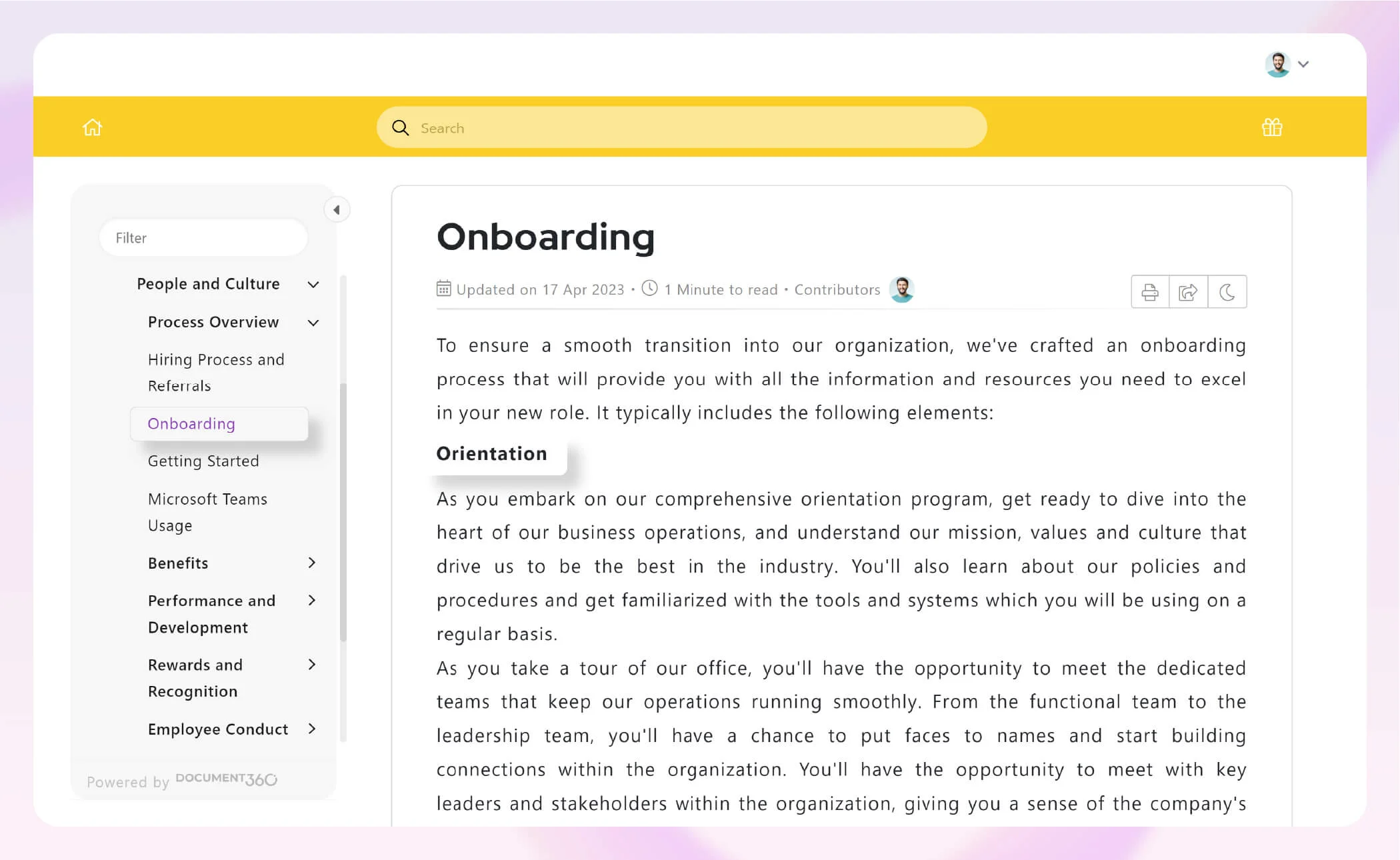
Integrations with many popular tools like Slack, Microsoft Teams, Zendesk, and more mean you won’t be losing out if you choose Document360. Sharing knowledge should be easy, and Document360 requires virtually no training before you can start documenting knowledge. This means your team is much more likely to adopt Document360 universally.
Document360 is a tool that enables you to benefit from the network effect of software. This phenomenon means that the more people use the tool, the more valuable it becomes. You can eliminate knowledge silos and connect teams in an enterprise with hundreds, or even thousands, of employees using Document360.
Features
Generative AI
Document360 is an AI-powered knowledge base for teams. It is especially geared towards using AI to help with the content creating process and also optimize search and knowledge discovery for your teams. AI features are built into every Document360 plan.
Analytics
Understand search success rate and most-read articles with Document360 analytics. Rich analytics enable you to take data-backed actions that will improve the knowledge base.
Information Architecture
The knowledge base is organized into articles and categories so your users experience a clear information architecture when navigating your content. It’s easier to find what they’re looking for and also a better content experience.
Continuous Development
We regularly add new features that improve Document360 in line with current trends and customer needs. We consider user feedback and use it to develop our product.
Supported Migration
The Document360 team will help you migrate your existing content from any platform into Document360.
User opinion about Document360 from G2
“We transitioned our customer knowledge base to Document360 in January 2022, which was previously created via Madcap Flare. The Document360 team was easy to communicate with and made sure our migration went smoothly. Customer support is always happy to help and answer questions, usually going above and beyond. The Doc360 Portal is easy to use and very intuitive and has made collaboration across our team so much more efficient. The team is constantly listening to the customers’ feedback and introducing bug fixes and new features.”
Feature Comparison Table
|
Document360 |
Confluence |
SharePoint |
|
User-facing knowledge base(Internal, external, or hybrid) |
Shared workspaces |
Hubs and microsites |
|
AI-powered search with Ask Eddy assistance |
Limited search |
Search all sites, folders, pages, lists, wikis, files, and libraries |
|
Analytics- (User, search, individual, performance) |
One-year analytics |
Page analytics and usage data |
|
Drag-and-drop homepage builder |
In-built templates |
Site templates |
|
AI writer |
AI-human collaboration |
Microsoft Copilot integration |
Wrapping up
When it comes to choosing between Confluence and SharePoint, both tools are relatively similar. With SharePoint, you’ll find that distinctive Microsoft feel, while Confluence is trusted particularly by agile teams. Many users are accustomed to SharePoint and feel comfortable with it. Confluence can be more sociable and fun to use, encouraging collaboration and sharing.
If all you want is a knowledge base without the fuss, then Document360 could be a great fit for your business. Entirely dedicated to knowledge management and content creation, Document360 is a highly intuitive tool for businesses large and small.
An intuitive knowledge base software to easily add your content and integrate it with any application. Give Document360 a try!
GET STARTED



 –
– 

